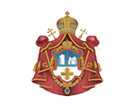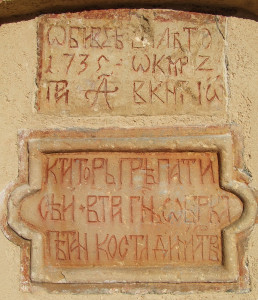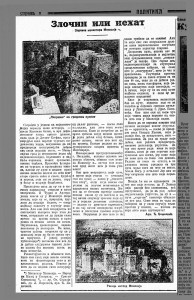-
Chronology
-
-
— 1407
-
According to Constantine the Philosopher, the year when the construction of the monastery began.
-
— 1418
-
The construction of the Resava monastery lasted more than ten years. Inside the monastic yard, surrounded by high fortifications and towers, was built the church of the Holy Trinity, the monumental refectory, the buildings with the cells of the monks, and maybe even the residence of the Despot. The chroniclers wrote that Resava was built in 1418 and then, “they settled down in the new quarters of Resava, the “Holy Trinity”.
The consecration of the church ensued immediately , during the day of celebration of the Holy Spirit, in the presence of the Patriarch Cyril (Kirilo), the council of the first Serbian prelates, of the superiors and the nobles.
By describing this event, Constantine the Philosopher said that Despot Stefan then gathered and installed in Resava “numerous reputed monks” and he offered to the monastery “villages and vineyards, icons decorated with gold and pearls, the official registers, chasubles and ecclesiastic recipients” and “ day after day he laid in this treasure”. Unfortunately today, it is not exactly known what has been preserved. As the archaeological excavations of the monastery began, we can expect that a part of this treasure can eventually be found.
By bringing educated monks to the monastery, the founder of Resava probably wanted his foundation to become an important spiritual and cultural centre. A very important work of translation and transcription was established at the beginning of the 15th century in Resava, owing to the efforts of the Despot, and a spelling reform was implemented. The books copied in Resava were higly valued, and so were their “translators”.
-
— 1427
-
On Saturday, 19 July (1 August), Despot Stefan Lazarević suddenly died while hunting near the Crkvina hamlet, between Stojnik and Markovac. His biographer noted that people prostrated themselves on the ground crying for him not only as their ruler but “as a well respected and beloved father”, and stated that “he was carried towards the tomb he had built for himself in Resava”. The Despot’s burial site has been a dilemma for centuries.
The monument with an inscription about the death of Despot Stefan was erected in 1427 in the churchyard of Saint Elijah in the Crkvina hamlet, part of the Markovac village.
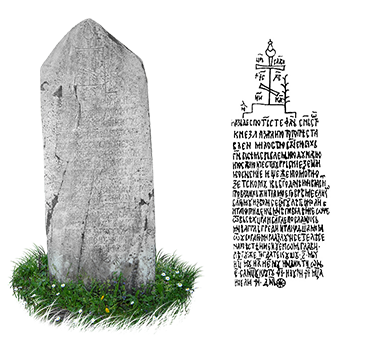
-
— 1437
-
Our chroniclers recorded that ten years later (1437) Kalojan Rusota, of Greek origin, a customs officer from Novo Brdo was buried in the Church of the Holy Trinity. His tomb is located in the south-east corner of the narthex, opposite the Despot’s tomb.
The change on the Serbian throne and instability in the state led to the Hungarian-Turkish war (1435-1437). The Hungarians manage to penetrate Serbia as far as Stalać and Kruševac, which immediately triggered the Turkish counter-attack.
-
— 1439
-
The fall of Smederevo under the Turkish rule meant the fall of the Serbian Despotate – our chronicles indicate that “Emperor Murad received Smederevo and Resava” that year. It was when the Manasija monastery first fell under the Turkish rule. The first plight of the monastery.
-
— 1444
-
The Peace of Szeged treaty was signed on 15 August between the Serbian Despotate and the Ottoman Empire after the Long War. This treaty meant that Serbia was no longer at war with the Turks. It thus avoided the disaster at Varna in November of the same year. Murad returned the land to Đurađ Branković and withdrew his army.
-
— 1456
-
The chroniclers state that Resava burned that year. It is not known what the extent of damage was, although it can be assumed that the refectory, and perhaps some other representative buildings, burned down. Towards the end of that year, Despot Đurađ Branković died.
-
— 1458
-
The dispute over the inheritance after the death of Despot Đurađ Branokvić allowed the Turks to capture Resava.
-
— 1459
-
The final fall of the Despotate under the Ottoman rule.
-
— 1468
-
The population census states that a castellan with a 70 strong garrison were located in Resava, which indicates that the fortified monastery was important for the Turks as a strategic stronghold of their defence system. The then garrison census also mentions 14 stone-masons and builders, which shows that the monastery fortification was damaged and that the Turks wanted to repair it for defence purposes. The same census also mentions two monks with the obligation to serve the fortress, which means that the monastery was not abandoned after all.
-
— 1474
-
The Turks removed the great bells in Resava, as punishment for the monks’ betrayal.
-
— 1502
-
F. Pentačić travelled in this region and described a church in Resava as a „glorious church, renowned for the tombs of kings and princes“. It is unknown whose tombs he saw in the church.
-
— 1515
-
These are the last data on the monastery. After the border moved to the north, Manasija lost its strategic importance for the Turks, so there were no news about it for almost two centuries.
The fortress maintenance and repair were carried out by the villagers of nearby Orašje. An imam and hatib (preacher) in the fortress were mentioned for the first time, meaning that there was a Muslim place of worship. It is also worth noting that the same census lists the muselims (horsemen) from the lower town, who must participate in military campaigns as necessary. The lower town is assumed to have grown to the south-west of the monastery, on the slopes towards the river, and that many structures were built there over time.
-
— 1689
-
For a short time, Austrians held the fortress, but the Turks soon recaptured it.
-
— 1718
-
The Treaty of Požarevac was signed on 21 July between Austria and Venice on one side and the Ottoman Empire on the other. The Resava Monastery was to be ruled over by the Austrians.
-
— 1733
-
The period of Austrian occupation of the monastery was marked with a certain level of construction activity. The reconstruction of the narthex, destroyed in a gunpowder explosion, began at that time. Maksim Ratković, an exarch of the Belgrade Metropolitan Vićentije Jovanović, travelled the north and north-east Serbia and produced a report on the state of the churches. He said about Resava, that its narthex was destroyed as it had held “a Turkish gunpowder magazine, but it is now being restored”. The exact time the works began remains unknown.
-
— 1735
-
The reconstruction of the narthex was completed in the autumn. This is recorded in an inscription on two stone plates, placed above the western window of the narthex. They read as follows:
RECONSTRUCTED ON 2 OCTOBER IN THE YEAR OF 1735 DURING THE OFFICE OF A(RCHBISHOP)
ВИКЕНТ(ИЈУ) ЈО(ВАНОВИЋУ). КТИТОР ПРИПРАТЕ ОВЕ ДРУГИ;
OBER-CAPTAIN KOSTA DIMITRIJEVIĆ, ESQ.
The mention of the prior Joasaf, who, according to Maksim Ratković’s report “lived there with his monk brethren” is important. This is the first piece of information after a long time about monastic brotherhood in Resava. It seems that in that period, the monastery had a school for monks, and that transcription activity resumed.
-
— 1736
-
In the Manasija monastery, deacon Jevrem completed the transcription of the “Miracles of the Holy Mother of God” , and his transcript has been kept in the monastery library to this day.
-
— 1790
-
According to a report dated 17 September of that year from the Military Archives in Vienna, as well as the request of the Court Military Council in Vienna, the Turks had invited about two hundred Serbs to worship at Manasija and slain them all.
-
— 1806-10
-
Between the Austrian departure 1739 and the First Serbian Uprising, the monastery was held by the Turks, so its spiritual life probably died out. It was revived owing to the efforts of monk Joanikije, who came to the monastery at that time. As the prior of the Resava monastery, he left behind two inscriptions in which he said that under the Serbian Vožd (Grand Leader) Karadjordje, Metropolitan Leontije, and Oberknez (local administrator) of Resava Milija Zdravkovć, and owing to his (Joanikije’s) efforts “the temple to the Holy Spirit was reconstructed”. These inscriptions, unfortunately, have not been preserved. We know that one of them was placed above the west door, while the other was to the right above the entrance.
-
— 1839
-
Prince Miloš Obrenović visited the Manasija monastery in 1832 and then ordered an inventory of all monasteries and churches to be created. The report from that year stated that Manasija was in very poor repair, and that the church posed a risk to both the monks and the people, as stones kept falling from the walls.
-
— 1844
-
Extensive works were undertaken. Owing to preserved documents we know that three vaults were re- built (probably on the narthex), many blocks of sand stone on facades were replaced by new ones, cornices were carved out of stone, and new wooden windows and doors were made, and that the interior walls of the church were plastered. At that time the prior of Manasija was Isaija, who took particular care of the monastery land. He built the bell tower and purchased three bells, reconstructed the church of the Nativity of the Mother of God in Beljajka, and purchased fields, meadows and a vineyard. The inventory of monastery property at the time also mentioned a watermill with 5 wheels. We assume that it describes the watermill in downtown Despotovac. In its vicinity, the prior built an inn and a store, which have not been preserved. At that time, the surrounding municipalities built a school in the monastery.
-
— 1856-58
-
The Manasija prior was Evgenije Smionović. He replaced the old watermill and gunpowder magazine with new ones, refurbished the residence, and purchased the robes and zeons. The Russian Empress, Marija Aleksandrovna donated a “Tetraevangelion” (Book of Four Gospels) in silver and gold and a gold plated cross.
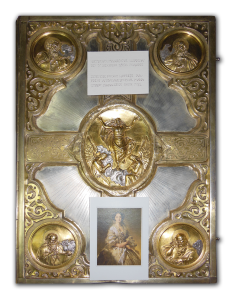
Painter Stevan Todorović (1832-1925) made a lithograph of Manasija at the request of prior Evgenije in 1858. It has been a valuable artistic source to this day. The greatest contribution of Evgenije Simonović is his description of the monastery and buildings in it. Besides detailed information about the church and the fortification, he wrote that “there were stores and Turkish taverns outside the city” and that the Turks “also built a mosque”.
-
— 1864
-
A tall iconostasis was put up in the church. The icons were painted by Milija Marković and his son, Nikola.

-
— 1895
-
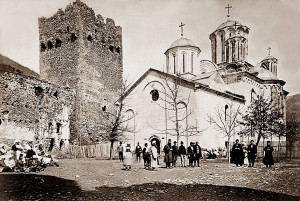
The late 19th century saw some interventions on the church, as recorded on the stone plate with an inscription, which used to stand immediately above the door to the narthex, and is now below the ridge of the roof. It reads:REPAIR 1895 UNDER THE RULE OF H.R.H ALEK(SANDAR) I, S.M KIRILO
It is assumed that during the earthquake of 1893, which was strongly felt in Manasija and its vicinity, the eastern part of the church suffered damage, and a crack appeared, and that a part of the cornice fell off the main dome. This inscription probably refers to the repairs at that time.
-
— 1927
-
The Serbian Orthodox Church canonized Despot Stefan Lazarević as Saint Stefan, Serbian Despot, celebrated on the 1 August.
-
— 1929
-
There was no more construction in the early 20th century. The fortification crumbled gradually and the existing residential buildings were maintained to the extent needed to accommodate a probably small monastic community. That is why an order was issued to demolish the upper parts of the towers, make the walls level and pour concrete over them. It was thought that the walls would be secured in this way. This is how the original parts of the towers were demolished and parts needed for their reconstruction irreplaceably destroyed. An article in Politika daily dated 12 October 1929 is a testimony to the attitudes of the people towards this event.
-
— 1932
-
A two-storey residence was built in the churchyard, to the east of the medieval refectory.
-
— 1954
-
Manasija became a convent.
-
— 1965
-
Of all the old monastic buildings, besides the church and the refectory, only the “small” residence to the right of the entrance to the churchyard was preserved and restored. There is a chapel dedicated to the Holy Cross on its first floor.
-
— 1977
-
A modern residence was built to accommodate numerous nuns. The residence was placed in the eastern part of the churchyard.
-
— 1985
-
A residence for the guests was built in the north-east part, with a library and an official dining room.
-
— 2006
-
The Founder’s Tomb in the naos of the Holy Trinity church was uncovered during the systemic archaeological research in 2006. The mortal remains of Despot Stefan Lazarević were discovered the southwest corner. Their authenticity was confirmed with a DNA analysis.
-
— 2007
-
Manasija celebrated its 600 anniversary.
-
